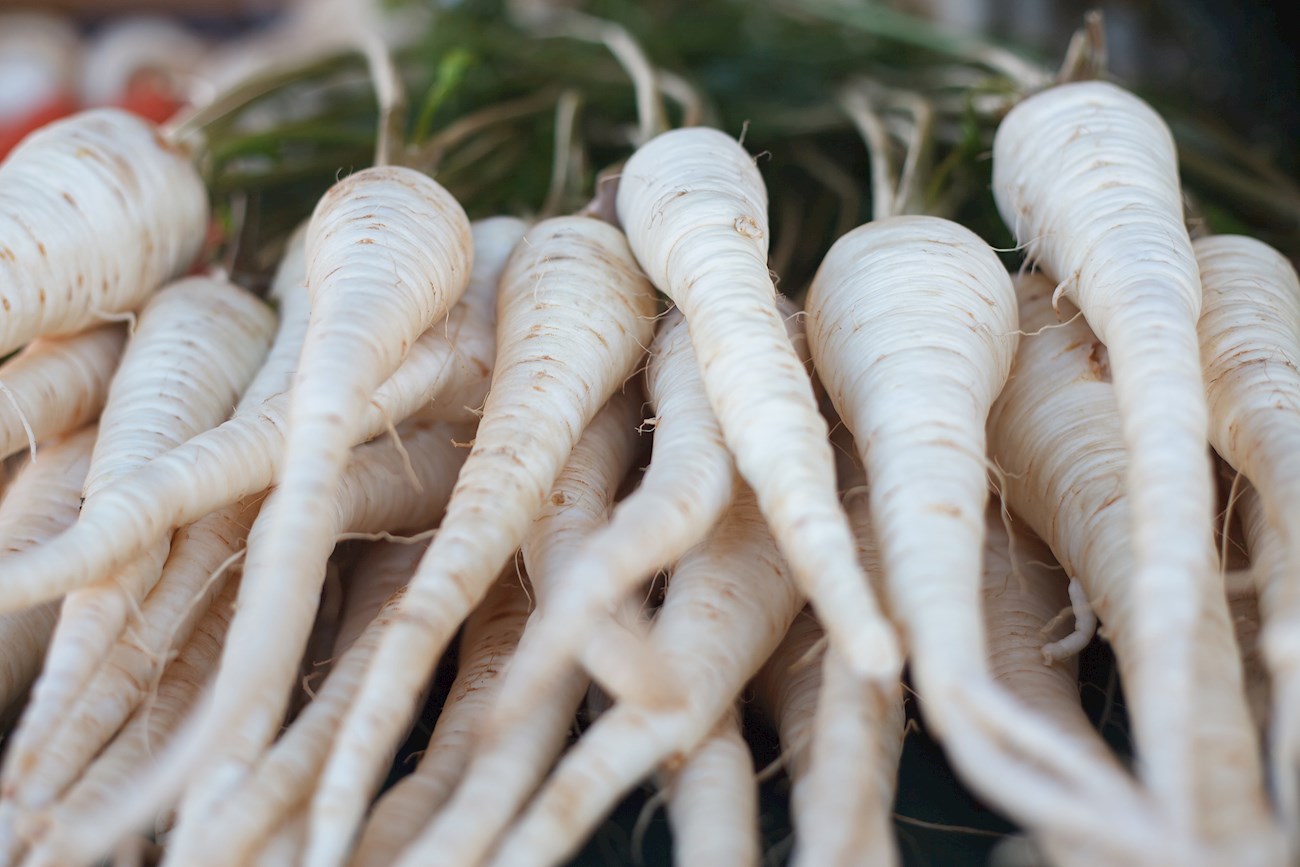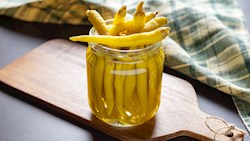Fenland celery is a vegatable belonging to the Apium graveolens species, using traditional methods of growing and harvesting by hand in the area of Cambridgeshire, Suffolk and Norfolk. It is white to green in color, with a brittle, crisp, crunchy and tender structure.
Its unique flavor is rich, nutty and sweet / salty / bitter in equal parts, with mild aniseed overtones. Because of the special growing technique, more of the root is allowed to be kept which is a specially flavorsome part of the celery. Fenland celery is available only from October to December and goes well in salads, soups, with tuna steak, or used in refreshing beverages.
Hegykői petrezselyemgyökér is a Hungarian root parsley originating from the vicinity of Lake Fertő in Győr Moson Sopron County in the Western Transdanubia region. This root parsley is produced by growing the Petroselinum crispum L, and the varieties used include Berliner Halblang, Fakír, Eagle, and Arat.
The body is snow-white in color, smooth, and unbranched. The aromas and flavors are intensely spicy due to the soil and climate in the area in which it is grown. These factors also give the root a higher sugar content, as well as higher calcium and phosphorus values.
Chuño is an unusual variety of Andean naturally freeze-dried potatoes. The name comes from a Quechua word ch'uñu, which can be literally translated as freeze-dried potatoes. The potatoes have a very long shelf life and are often used in dishes such as stews and soups.
Before consumption, the potatoes need to be soaked in water in order to rehydrate. There are two basic varieties of these potatoes – black and white. White chuños are soaked in cold water, then sun-dried, while the black variety is left to freeze overnight, and is then crushed in the morning in order to extract the liquid, but at night, it gets frozen again, so the process is repeated until the potatoes are totally dehydrated.
Kanpyō refers to dried shavings of calabash gourd. Originally, it was grown in the Osaka area, but now it's a specialty of Tochigi Prefecture. These gourd shavings are usually used as an ingredient in sushi, stewed nimono, and marinated aemono foods.
When it's used for sushi, kanpyō is boiled to soften, then flavored with sugar, mirin, soy sauce, or dashi broth, depending on the recipe. Due to its mild flavor, kanpyō is sometimes used in Western-style salads.
Konjac is the widely used root, or a tuber, produced by the konjac plant, a crop native to China that is also very popular in Japan, where it has been cultivated since the 6th century. The root has an oval shape and is especially praised for its numerous beneficial properties.
It is rich in glucomannan sugar, a fiber widely used in powdered form that is incorporated in many traditional and modern remedies. In gastronomy, it is often used as flour that easily swells in liquid, so it is mainly employed as a thickening agent in dishes to give them a denser, jelly-like consistency.
Roikio is a wild herbaceous green, a type of spiny chicory that thrives on the island of Kasos, in the South Aegean. It is traditionally gathered in late winter and early spring, and locals usually preserve the plant's leaves in coarse salt for future use.
The leaves of this wild plant are considered to be an excellent source of healthy nutrients and they're appreciated for their sweet and slightly bitter flavor. Roikio can be enjoyed fresh, boiled, or pickled, and it's typically used in salads or stews.
Iceberg lettuce is a popular variety of lettuce known for its crisp, refreshing texture and mild flavor. It forms a dense, round head with tightly packed leaves that range from pale green on the outside to almost white near the center. This lettuce has a high water content, giving it a distinctive crunch that is particularly valued in salads, sandwiches, and wraps.
Its light and crunchy nature make it a favorite for adding texture and freshness to dishes, such as burgers and tacos, where it balances richer or spicier flavors. While iceberg lettuce is not as nutrient-dense as darker greens like romaine or kale, it still provides some vitamins, including vitamin A and K, and is very low in calories, making it a hydrating and refreshing choice.
Hajdúsági torma is a horseradish from the Hajdúság area in Hungary that has thick, green leaves on the upper part and a cylindrical, brownish root while the flesh inside is white. It is distinctive for its rich, hot flavor and extreme quantities of vitamin C (sometimes up to 150 mg/100 g).
The method of production also distinguishes this product from others because it uses a special ridge planting method, and the harvesting of the roots takes place in October. It can be sold as whole individual roots, or more often, grated with vinegar and packed in foil sacks.
Maca is the ancient root vegetable, a variety of radish, native to areas of Peru. It is extremely resilient since it is able to thrive in the harsh environment of the Andes, and many believe that it has many beneficial properties, which promotes it as one of the most common ingredients used in medical remedies.
In gastronomy, it is regarded as superfood, and is mainly used in powder form to provide a higher nutritional value to standard dishes. As any other root vegetable, maca is commonly served boiled or roasted, and is often incorporated in nourishing stews and soups.
Named after a small fishing port in the south of Venice's lagoon, Radicchio di Chioggia refers to Italian leaf chicory of the Precoce and Tardivo varieties, grown within the provinces of Venice, Padua and Rovigo. This robust leaf vegetable is rich in antioxidants, and characterized by a strong, bitter flavor.
When balanced with sweet balsamic vinegar or salty cheeses, the bitterness of raw radicchio can be quite refreshing, and it slightly mellows down if the chicory is grilled, braised or roasted. Apart from being enjoyed in various salads, Chioggia radicchio is often sautéed with garlic and anchovies, wrapped in bacon and grilled or used in the preparation of various risotto and pasta dishes.
TasteAtlas food rankings are based on the ratings of the TasteAtlas audience, with a series of mechanisms that recognize real users and that ignore bot, nationalist or local patriotic ratings, and give additional value to the ratings of users that the system recognizes as knowledgeable. For the “63 Worst Rated Vegetables in the World” list until March 26, 2025, 6,094 ratings were recorded, of which 3,313 were recognized by the system as legitimate. TasteAtlas Rankings should not be seen as the final global conclusion about food. Their purpose is to promote excellent local foods, instill pride in traditional dishes, and arouse curiosity about dishes you haven’t tried.
















































































